The surprising truth about Caesar salad
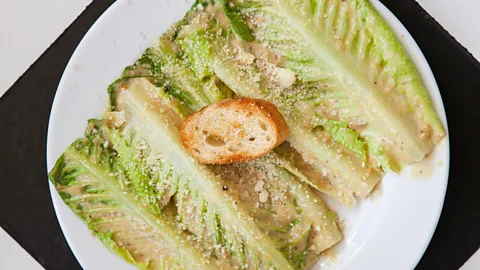 Lindsay Lauckner Gundlock/Alamy
Lindsay Lauckner Gundlock/AlamyIt was once called ‘the greatest recipe to originate in the Americas in 50 years’, but its origins are shrouded in mystery.
It was early Friday afternoon at the San Ysidro Port of Entry, the busiest land border crossing in the world, which connects Tijuana, Mexico, and San Diego in the US. Some Mexicans were returning home from a week of work, while some Americans were getting an early start to their weekend. I was heading to Tijuana to eat lunch at the restaurant that invented the Caesar salad.
That’s right: one of the US’s most famous dishes was invented in Mexico.
 Lindsay Lauckner Gundlock/Alamy
Lindsay Lauckner Gundlock/AlamyAfter getting my passport stamped and walking across the border, I wandered past discount chemists and souvenir stalls peddling ponchos on my way to Avenida Revolución. A 25-minute walk from the border, Caesar’s Restaurante-Bar has been located on Tijuana’s main drag since 1927. A couple of palm trees stand in front of the building, gently blocking the red letters spelling ‘Caesar’s’, and a giant black-and-white portrait of founder Cesare (‘Caesar’) Cardini hangs outside the patio with the words ‘Home of the legendary Caesar’s Salad’.
After immigrating to the US from Italy in the 1910s, Cardini opened a restaurant in Sacramento and later in San Diego. But to escape Prohibition, he moved across the border to Tijuana in the 1920s before opening his business in its current location in 1927.
As Cardini’s daughter, Rosa, famously recounted for decades until her death in 2003, her father invented his namesake dish on 4 July 1924. As legend has it, the restaurant was doing such brisk business on American Independence Day that it was running short on ingredients. On a whim, Cardini improvised a dish using romaine lettuce leaves, raw egg yolk, Parmesan cheese and other leftovers – transforming the odd scraps into a surprisingly delicious meal.
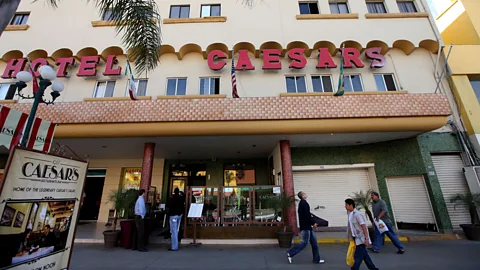 Sandy Huffaker/Corbis via Getty Images
Sandy Huffaker/Corbis via Getty ImagesI was far from the first person to cross the border to eat a salad at Caesar’s. Throughout the 1920s, hordes of American film stars flocked to Tijuana for Prohibition-banned booze, and word soon spread of Caesar’s eponymous salad among Hollywood elite. Clark Gable and Jean Harlow travelled to Tijuana to try Caesar’s crisp lettuce and richly dressed dish. And in her book From Julia Child’s Kitchen, acclaimed American chef Julia Child described one of her earliest restaurant memories as venturing to Caesar’s with her parents from their California home in the 1920s and watching Cardini prepare his creation at their table.
“It was a sensation of a salad from coast to coast,” Child wrote. “There were even rumblings of its success in Europe.”
In fact, the salad soon spread from Mexico and the Golden State across the globe. In the 1940s, Gourmet Magazine called the dish ‘the gastronomic highlight of the current moment’. And in 1953, it was even crowned as ‘the greatest recipe to originate in the Americas in 50 years’ by the International Society of Epicures in Paris.
The Cardinis packed up from Tijuana and moved to Los Angeles, where they patented their family’s famous salad dressing in 1948. Today, it’s still sold as Caesar Cardini’s Dressing. But while the brand is now based in the US, the restaurant that inspired the dish and its roots are planted firmly in Tijuana.
In many ways, Caesar’s recent history mirrors Tijuana’s. Once a glamorous haunt for Tinseltown stars and gangsters, the city spiralled into a decades-long wave of crime and violence before experiencing a recent cultural revival. In 2009, Caesar’s, which was no longer owned by the Cardinis and had deteriorated into a scruffy dive, closed. But in 2010, a local family – the Plascencias – reopened it after a total scrub-down.
“[Caesar’s is] an icon of the city,” said Javier Plascencia, a star chef in Tijuana whose family now runs the restaurant. “It’s one of the few pieces of cultural history that we have.”
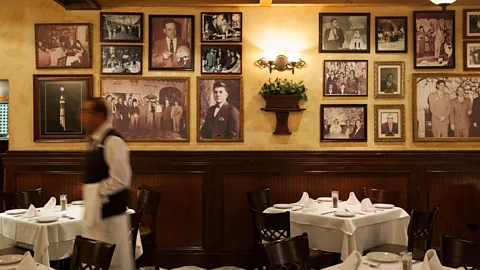 Lindsay Lauckner Gundlock/Alamy
Lindsay Lauckner Gundlock/AlamyToday, Caesar’s has an old European feel, with black-and-white tiles and a shiny mahogany bar. The servers’ crisp white shirts poke out from beneath black waistcoats and ties. Historic photographs of Tijuana decorate the walls, heavy beams cross a dark wood ceiling and the lighting is dim, giving the restaurant an intimate vibe.
Ordering the ensalada Caesar’s is like pressing the play button to an elaborate show. Caesar salad isn’t just a recipe: it’s a piece of choreography; a slow dance between creamy dressing and romaine lettuce.
The performance commences when the waiter rolls over the salad cart. The appointed ensaladero server tips a small spoonful of minced garlic into a large wooden bowl, and then adds mustard, plump anchovy fillets and a few drops of Worcestershire sauce. The server cracks an egg, and, with two carefully balanced spoons, drains the shell and tosses the yolk into the bowl. The waiter then squeezes in some lime juice, and zealously stirs everything in the bowl with wooden tongs. While stirring, the ensaladero drizzles in the olive oil and finely grated Parmesan cheese.
Once the dressing is mixed into more than the sum of its parts, the server tips in a plate of fresh romaine leaves and gently tosses everything together. The waiter then plates the salad, covering the leaves with a grinding of black pepper, a single, plain crostini and even more Parmesan cheese.
No cubed croutons, bacon bits or lemon juice.
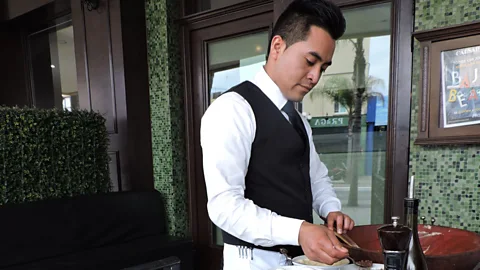 L Sasha Gora
L Sasha GoraDespite the salad’s name and the famous story Rosa Cardini recounted of her father, it’s unclear who actually invented the dish. In her book, The Essential Cuisines of Mexico, Mexican food authority Diana Kennedy suggests the salad was actually created by Caesar’s brother, Alex. According to Kennedy, Alex started working in the restaurant business at age 10 in Italy, before becoming an ace pilot in World War One and then moving to Tijuana in 1926 to join his brother and open his own restaurant. “First known as Aviator’s Salad, it then became popularly known and copied as Caesar, but I shall call it as it should be called: Alex-Caesar Cardini Salad,” Kennedy wrote.
A business partner of Alex and Caesar’s at their Tijuana restaurants, Paul Maggiora, also claimed that he was the first to toss this salad. Still another version of the story credits a young employee at Caesar’s: Livio Santini. Also from Italy, Santini moved to Tijuana in 1924, landed a job cooking for Cardini and allegedly threw together the salad based on a dish his mother used to make.
Today, even Caesar’s website asks, “Did Caesar Cardini or Livio Santini create the salad? We honestly weren't there when one of the world's most famous dishes was born. But we certainly honour and pay due respect to both Mr Cardini and Mr Santini.”
Whatever the true origins, as the salad moved north into the US, one of its key ingredients changed. Today, most recipes call for a splash of lemon juice, and not the fresh lime juice the ensaladero stirred into the dressing at my table. Even the Encyclopaedia Britannica defines it as a dish with lemon.
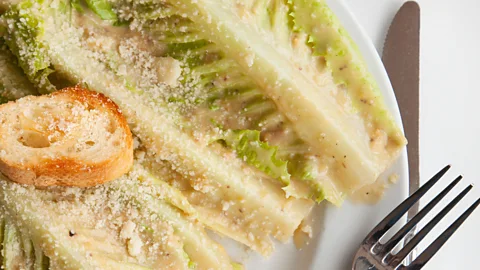 Lindsay Lauckner Gundlock/Alamy
Lindsay Lauckner Gundlock/AlamyJames Beard Award-winning food writer and cookbook author Carolynn Carreño was born in Tijuana and attributes this lemon-lime mix up to a simple misunderstanding. “The problem, as I see it, is that the word in Spanish for ‘lime’ is ‘limón’, which, of course, sounds an awful lot like ‘lemon’,” she wrote. To add to the confusion, the Spanish word for ‘lemon’ is also ‘limón’. Carreño’s father happened to work at Caesar’s in the 1950s tossing salads tableside, and as she pointed out, the original Caesar she ate as a child was always made with small, green Mexican limes.
Ninety-five years after someone in Tijuana tossed the first Caesar salad, the dish remains the most popular menu item at Caesar’s and a source of pride for locals. For the last seven years, Tijuana native Julio Alvarez has been working as a bartender at Caesar’s. “I’m the oldest one here,” he proudly told me. “[The salad is] very important… it is kind of like a monument for the people of Tijuana.”
We may never know the real story of whether Caesar, Alex, Livio or Paul created the dish, but one thing is for certain: an Italian immigrant invented one of the US’s most famous salads in Tijuana with romaine lettuce named after Rome. It’s a cross-cultural food – truly a mixed salad – and a dish worth crossing borders for.
Culinary Roots is a series from BBC Travel connecting to the rare and local foods woven into a place’s heritage.
Join more than three million BBC Travel fans by liking us on Facebook, or follow us on Twitter and Instagram.
If you liked this story, sign up for the weekly bbc.com features newsletter called "If You Only Read 6 Things This Week". A handpicked selection of stories from BBC Future, Culture, Capital and Travel, delivered to your inbox every Friday.
{"image":{"pid":""}}
